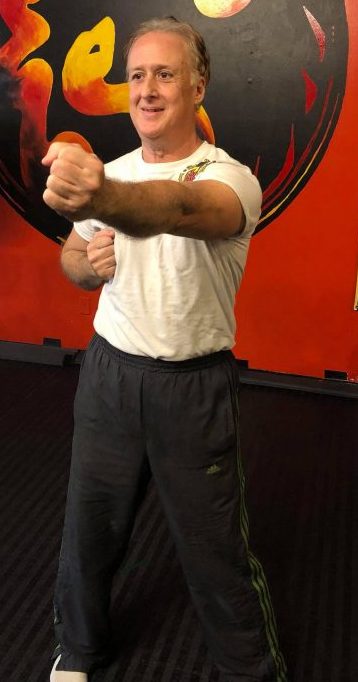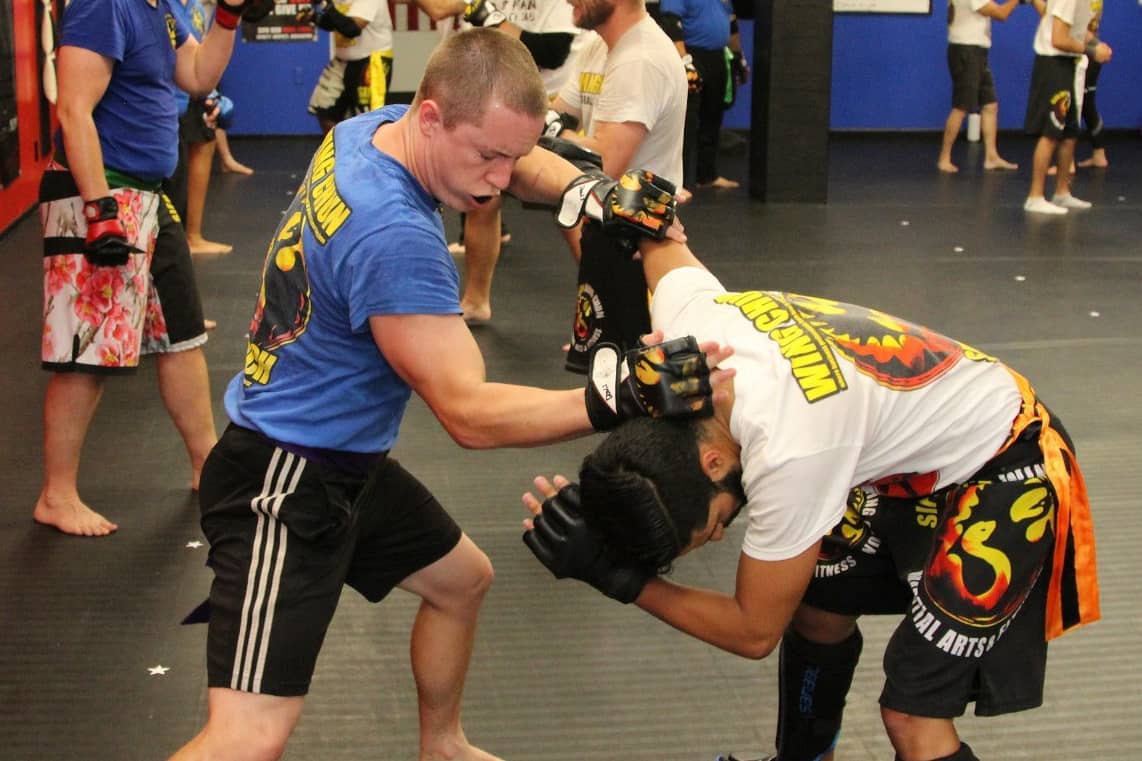Intercepting is always better than blocking. We are going to look at what the definition of intercepting is before we give some practical ways of accomplishing that. Webster’s dictionary defines intercepting as “to stop, seize, or interrupt in progress or course or before arrival”. The best way to view intercepting is that last part of the definition, “interrupt”. Not only is the attack itself being interrupted, but the timing of your opponent should be as well. And that is the key, the timing. When timed properly your opponents attack will be nullified and you will be primed to launch a second attack (in theory before his second) or you would have already hit him. Now that we have addressed what intercepting as a concept let me provide you with 4 Ways to Intercept your opponents attacks using Wing Chun.

4 Ways to Intercept: Option 1 – The Intercepting Fist

The first technique we will go over is the Intercepting Fist. Made famous by Bruce Lee, this technique is typically taught fairly early on in student’s training. The idea is to counter the opponents punch with a punch of your own. By keeping your elbow down and pressing from center mass you are elbow to offset your opponents strike. This can quickly be follow up a flurry of punches we refer to as Chain Punches. Keeping the strikes down the center you are able to maintain control of your centerline.
When you substitute a Paak Sao with an intercept you will find it can be much easier to deal with a second and third punch. Part of this is due to the fact that you are returning the opponents punch with a punch. They will be slightly less confident with their next punch as opposed to when you simple deflect their initial punch with a Paak. Second to that, the Intercept automatically covers your opposite side incase of a second attack. Whereas the Paak leaves you more open.
4 Ways to Intercept: Option 2 – The Turning Punch
The Turning Punch basically the other side of the same coin referring to the Intercepting punch. The Intercepting fist is typically used to refer to the lead hand being used with the lead foot to interrupt the opponent. This is illustrated in the first photo to the right.

Turning punch is simply using the the same structure but opposite hand to accomplish the same goal. Since the punch is coming from the back foot, the turning punch will have more power and torque then the straight Intercepting. However, much like the Paak punch, if not used properly, can leave you open on the inside for an attack.
4 Ways to Intercept: Option 3 – The Tan Sao

The Tan Sao is a very effective and sound way to intercept a strike. You have not only nullified the attack but you have also almost guaranteed a strike of your own. Tan and the actual punch are the exact same shape. The only exception is what the hand is doing at the end. You can see here in the photo the Tan Sao is an hand open towards the ceiling. By opening the hand the focus of the technique is diverted to the elbow. The Punch itself can be delivered to the head, or for a taller opponent you can strike the ribs.
Since the Tan extending through the strike towards your opponent, it makes stopping a second strike fairly straight forward. You can transition to a Paak Punch if the Strike is down the center. Or, you can continue pressing forward with a Bui Sao against a hook punch.
4 Ways to Intercept: Option 4 – The Paak Punch

Our last technique for this article on intercepting attacks is the Paak Punch. Clearing the attackers hit with Paak good, but combining it with straight punch is better. Since the Paak is coming off of the back foot there is a lot of power and structure with this counter. The Paak is also quite diverse.
When used, you can use the Paak to press forward and crush the attackers structure. You can guide his hand downward if he is taller. You can also use it to setup a baiting for the second punch.
Bonus: The Paak Punch is also a great attack to throw in a kick along with it. By doing this you maximize Wing Chun’s ability to use multiple weapons at once. You can see here in the photo, Sifu Justin used the Paak, Punch, and Kick. He uses the kick just before the punch clears the arm to finish the attack.
Final thoughts
When it comes to Intercepting timing is everything. You can have GREAT structure, technique, and power. But, if you do not practicing your techniques in LIVE sparring scenarios you will get hit no matter how good you think you are. There is no substitute for hard work, and good punches to the face. Train hard and never give up.
Why Choose Sifu Och Wing Chun
Practicing provides numerous benefits, including:
- Physical Fitness: Enhance strength, flexibility, and endurance.
- Mental Clarity: Develop focus and discipline through structured training.
- Self-Defense Skills: Learn effective techniques for personal safety.
- Cultural Enrichment: Gain insight into a centuries-old tradition.

Want to Get Started?
Join Sifu Och Wing Chun today and embark on your journey through the world. Fill out our contact form to discover why we are your best choice for Wing Chun Kung Fu and martial arts training in Lakeland, Florida!
Related articles on the Sifu Och Wing Chun website:
Empower Yourself: Experience Personal Growth Through Chinese Martial Arts
https://sifuochwingchun.com/chinese-martial-arts-lakeland-florida-kung-fu/
Unlock Potential: The Incredible Strength of Wing Chun Martial Arts
https://sifuochwingchun.com/the-strength-of-my-wing-chun/














 If anybody is in the 40s or 50s age and would like to learn some self-defense they should not hesitate. They should come down to Sifu Och and start their own journey! Your age shouldn’t hold you back. I’m 58 but that is just a number. I don’t allow that to be an excuse to not learn something new. Life can be very hard. And many times you want to just give up. But the wonderful things in life take some time to learn.
If anybody is in the 40s or 50s age and would like to learn some self-defense they should not hesitate. They should come down to Sifu Och and start their own journey! Your age shouldn’t hold you back. I’m 58 but that is just a number. I don’t allow that to be an excuse to not learn something new. Life can be very hard. And many times you want to just give up. But the wonderful things in life take some time to learn. Sal shows that now matter your age you can accomplish anything with hard. Day after day Sal comes into class and puts in a hard days training. Starting from private lessons he has been able to work himself into the group classes. The most impressive thing about Sal is his determination. He doesn’t care about belts, or awards, or flashy techniques. He simply wants to know that he can take care of himself. Each day he comes in and builds himself from the last class.
Sal shows that now matter your age you can accomplish anything with hard. Day after day Sal comes into class and puts in a hard days training. Starting from private lessons he has been able to work himself into the group classes. The most impressive thing about Sal is his determination. He doesn’t care about belts, or awards, or flashy techniques. He simply wants to know that he can take care of himself. Each day he comes in and builds himself from the last class.

























































 Moving on to the hand itself and how it is used, there are again two options. The hand, if striking towards the eyes, should actually be kept loose. If the fingers are stiff there is a likely chance of a break due to the eye being encased in bone. There is an exception to this: The fingers can and should be stiff if using the same technique when striking the throat. With a fast whipping motion, the fingers are thrust forward into the eye of the opponent simulating the striking of a snake.
Moving on to the hand itself and how it is used, there are again two options. The hand, if striking towards the eyes, should actually be kept loose. If the fingers are stiff there is a likely chance of a break due to the eye being encased in bone. There is an exception to this: The fingers can and should be stiff if using the same technique when striking the throat. With a fast whipping motion, the fingers are thrust forward into the eye of the opponent simulating the striking of a snake.
